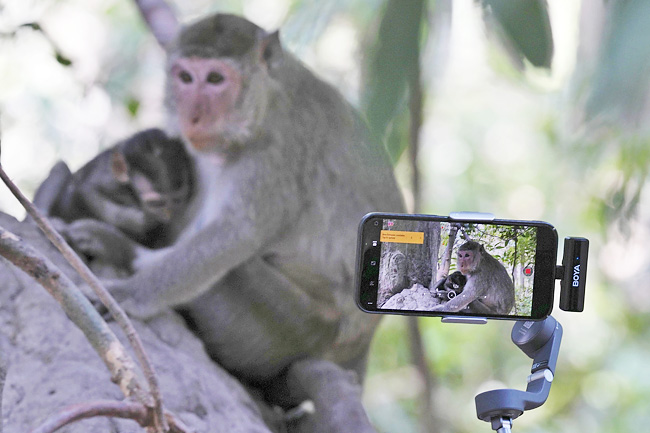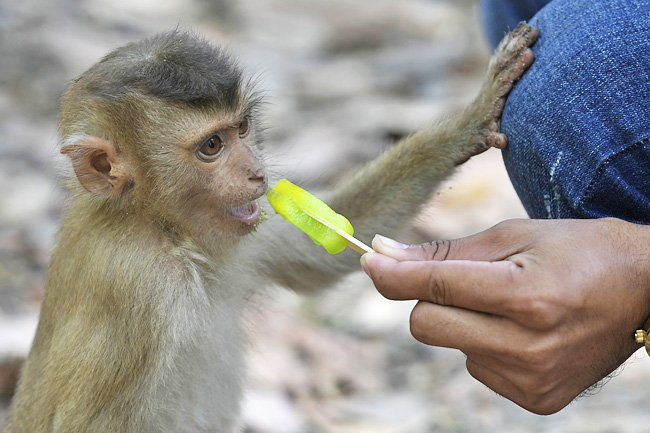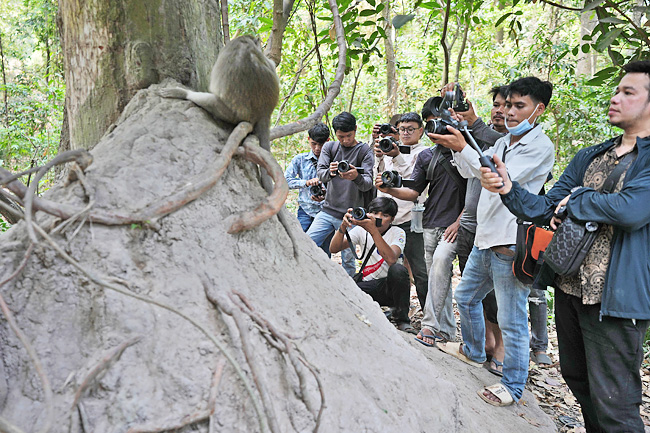AP – A baby monkey struggles and squirms as it tries to escape the man holding it by the neck over a concrete cistern, repeatedly dousing it with water.
In another video clip, a person plays with a juvenile male macaque sitting on a limestone block from an ancient temple to get it excited for the camera.
The abuse of monkeys at the Angkor United Nations Educational, Scientific and Cultural Organization (UNESCO) World Heritage Site in northwestern Cambodia is not always so graphic, but authorities said it is a growing problem as people look for new ways to draw online viewers to generate cash.
“The monkey should be living in the wild, where they are supposed to be living, but the monkey nowadays is being treated like a domestic pet,” said spokesperson Long Kosal for APSARA, the Cambodian office that oversees the Angkor archaeological site.
“They’re making the content to earn money by having the viewers on YouTube, so this is a very big issue for us.”
APSARA has few tools itself to stop the YouTubers from filming in general, but has opened an investigation with the Ministry of Agriculture to collect evidence for legal action against the most serious abusers – who are rarely on camera themselves, Long Kosal said.
“If we can build a case, they will be arrested for sure,” he said. “Any animal abuser will be seriously punished by law in Cambodia.”





YouTube, Facebook and other sites remove the videos with graphic content, but scores of other clips of cute monkeys jumping and playing remain, generating thousands of views and subscribers.
Just making those videos involves very close interaction with the monkeys, however, which authorities and animal-rights activists said creates a host of other problems, both for the macaques and people visiting one of Southeast Asia’s most popular tourist sites.
On a recent day outside Angkor’s famous 12th-Century Bayon Temple, at least a dozen YouTubers, all young men, crowded around a small group of long-tailed macaques, pushing in close to get shots of a mother with a baby on her back and tracking her everywhere she moved.
The wild monkeys feasted on bananas tossed to them by YouTubers and drank from plastic bottles of water.
One young macaque briefly amused itself with half-eaten neon-green popsicle discarded at the side of the path, before dropping it to move on to a banana.
A blue-shirted APSARA warden looked on but those filming were unfazed, illustrating the main problem: Simply taking video of monkeys is okay, even though feeding them is frowned upon. At the same time, it’s making them dependent upon handouts, and the close interaction with humans means they’re increasingly becoming aggressive toward tourists.
“The tourists carry their food, and they would snatch the food,” Long Kosal said, flipping through multiple photos on his phone of recent injuries caused by the macaques.
“If the tourists resist, they bite and this is very dangerous.”
The search for food from tourists also draws the monkeys from the surrounding jungle in to the ancient sites, where they pull away pieces of the temples and cause other damage, he added.
Tourist Cadi Hutchings made sure to keep her distance from the monkeys, after being warned by her tour guide of the increasing risk of being bitten.
“What they want is your food, but you also need to appreciate that there needs to be a boundary between human intervention in nature,” the 23-year-old from Wales said.
“It’s obviously a great thing that so many tourists come because it’s such a lovely place, but at the same time, you have to be careful that with more and more people the monkeys don’t get too acclimatised.”
Many other tourists, however, stopped to take their own photos and videos – some holding out bananas to draw them closer – before heading to the nearby temple site.
YouTuber Ium Daro, who started filming Angkor monkeys about three months ago, followed a mother and a baby along a dirt path with his iPhone held on a selfie stick to get in close.
The 41-year-old said he hadn’t seen any monkeys physically abused, and that he didn’t see a problem with what he and the others were doing to make a living.
“The monkeys here are friendly,” he said. “After we take their pictures we give them food, so it is like we pay them for them giving us the chance to take their picture.”
As he spoke, a young macaque scrambled up the leg of an onlooker, trying – unsuccessfully – to grab a plastic bottle of water out of his pocket.
One YouTuber said he had started filming monkeys during the COVID-19 pandemic after the numbers of tourists plummeted, making it impossible to earn a living as a tuk-tuk driver.
Daro said he was looking for a way to supplement his income as a rice vendor, and that he’s too new at it to have realised many returns.




